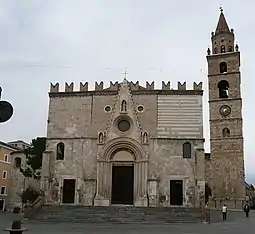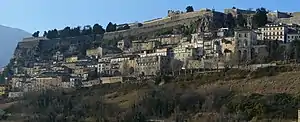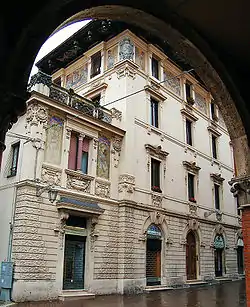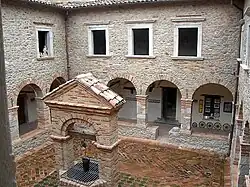Province of Teramo | |
|---|---|
 Teramo mainlain seen from Atri | |
 Coat of arms | |
 Map highlighting the location of the province of Teramo in Italy | |
| Country | |
| Region | Abruzzo |
| Capital(s) | Teramo |
| Comuni | 47 |
| Government | |
| • President | Diego Di Bonaventura |
| Area | |
| • Total | 1,948 km2 (752 sq mi) |
| Population (28 February 2011) | |
| • Total | 312,311 |
| • Density | 160/km2 (420/sq mi) |
| GDP | |
| • Total | €7.093 billion (2015) |
| • Per capita | €22,825 (2015) |
| Time zone | UTC+1 (CET) |
| • Summer (DST) | UTC+2 (CEST) |
| Postal code | 64100 |
| Telephone prefix | 0861 |
| Vehicle registration | TE |
| ISTAT | 067 |
The province of Teramo (Italian: provincia di Teramo; Abruzzese: pruvìngie de Tèreme) is a province in the Abruzzo region of Italy. Its capital is the city of Teramo. The province has an area of 1,948 square kilometres (752 sq mi), a population of 313,029 (2012), and is subdivided into 47 comuni (SG: comune), see comunes of the province of Teramo. The province of Teramo shares its northern border with the province of Ascoli Piceno in the Marche region, southern and southwestern borders with the province of L'Aquila in the Abruzzo region, and a western border with the province of Rieti in the Lazio region. To the south is the province of Pescara in the Abruzzo region and to the east is the Adriatic Sea.
Geography


The landscape of the Province of Teramo is dominated almost entirely on the east by a large body of water with the beaches of the Adriatic sea and by the Apennine Mountains which his highest peak of Gran Sasso d'Italia westside. The province is indeed divided latitudinally by the characteristic hills and valleys rich in vineyards and olive groves that begin in the Apennines and run almost to the coast. Colline Teramane (Teramo Hills) has become a trademark and are one of the most significant areas where extra virgin olive oil and Abruzzo wines are produced.[2] Unique of the province of Teramo is the short distance between the beaches of the Adriatic sea and the 3,000-metre (9,800 ft) snowcapped Gran Sasso peaks. They can be reached within an hour from one point to the other. The peaks of the Gran Sasso rise to the west of the Province of Teramo while those of the Monti della Laga dominate its northern border. These two ridges are among the most distinctive and the most relevant of the entire Apennine Mountain range. The majestic Gran Sasso rises at its peak, the Corno Grande, to an elevation of 2,912 metres (9,554 ft) and is characterized by steep, and in places virtually inaccessible, gorges with nature reserves and protected living species. A good part of Gran Sasso and Monti della Laga National Park is nestled in the province. Calderone, the southernmost glacier in Continental European, is found nearby. In contrast to the rugged and isolated Gran Sasso area, the Monti della Laga are characterised by thick forests, shallow gorges, rolling slopes and valleys, and several spectacular waterfalls. In addition to the provincial capital, the most populous and important commercial centers include Roseto degli Abruzzi and Giulianova with populations of 25,000 and 24,000 inhabitants respectively. On the eastern portion of the province are the so-called "seven sister" beaches directly adjacent to the Adriatic Sea. These resorts are noted for one of the highest blue flag beaches density, very fine white sand and their mild and wholesome Mediterranean climates which support a rich flora of palm, pine and oleander trees. Much of the province is hilly and very few large flat plains are to be found. Running from the west to the east are a number of valley streams and rivers which eventually empty into the Adriatic Sea. The province of Teramo can easily be reached by car or bus from Rome via the A24 highway and it is also connected to the A14 highway.
Culture
Towns in the province of Teramo include Civitella del Tronto and Atri. The first stood as the northernmost protective point of the Kingdom of the Two Sicilies. In Atri there is a Roman Catholic cathedral and a theatre. The provincial capital of Teramo hosts a large cathedral and has for centuries served all of Abruzzo as a main administrative and economic center.
On 15 September 2005 the President of Italy, Carlo Azeglio Ciampi, went to Teramo to make a special presentation in honour of the resistance movement that arose in this town against the Nazi forces during the Second World War. A special note was made of the young Italian partisans who gathered in the village of Bosco Martese. There they risked deportation, severe reprisals, and other barbarous acts.[3]
Tourism

Main tourist attractions include:
- Atri, including an erosion phenomenon called "Bolge" and see the treasures of the Count of Aquaviva.
- Campli - a characteristic village once possession of the Farnese Family. Its St Paul Church holds a Scala Sancta.
- Castelli is a village 25 miles away (40 km) from Teramo. It is known for its maiolicas. In the past local artisans produced ceramics for most of the royal houses of Europe.
- Civitella del Tronto - Bourbon fortress which is the most visited monument of the Abruzzo region, surrounding village e and gole del Salinello.[4] The place holds a significant importance in the history of Italy unification.
- Colline Teramane (Teramo hills) are a very distinctive and significant area where extra virgin olive oil and Abruzzo wines are produced.[5]
- Giulianova - an example of renaissance ideal city on the Adriatic Sea founded by Giulio Antonio Acquaviva.
- Montagne Gemelle (Twin Mountains) of the Gran Sasso and Monti della Laga National Park are two suggestive mountains standing alongside. They are often taken as one of the symbols of the province of Teramo.
- Montorio al Vomano - historical medieval town and its cathedral.
- Teramo - cathedral and museums.
- Gran Sasso and Monti della Laga National Park.
- The Shrine of Gabriel of Our Lady of Sorrows with average of 2 million visitors per year is one of the 15 most visited sanctuaries in the world.[6]
From north to south, the province of Teramo boasts several blue flag beaches on the Adriatric Seacoast, called the seven sisters, are the following:
Transportation
Major highways
The Province of Teramo can be reached from the north and the south by the main highway, the A14, that runs along the Adriatic Coast. It can be reached from the west by the A24 coming from Rome via L'Aquila.
Railroad lines
The central railroad station of the province is located in Giulianova. From here is it possible to follow the coastline to the north and south or to travel in a westerly direction towards the provincial capital.
Seaports
The port of Giulianova is the maritime terminal of the Province of Teramo.
Administration
Since 2009, the president of the province has been Valter Catarra of the centre-right political party.
Major comuni
The main comuni (municipalities) by population as of 2005 are:
Teramo (52,794), Roseto degli Abruzzi (23,669), Giulianova (21,875), Silvi Marina (15,247), Martinsicuro (15,047), Pineto (13,763), Atri (11,269), Alba Adriatica (11,219), Sant'Egidio alla Vibrata (9,177), Mosciano Sant'Angelo (8,559), Tortoreto (8,536), Montorio al Vomano (8,072), Campli (7,598), Bellante (7,208).
Frazioni
Gallery

 Giulianova seaside
Giulianova seaside Prati di Tivo ski slopes
Prati di Tivo ski slopes

-Italy.jpg.webp)
 Coast
Coast Abruzzo Chamois
Abruzzo Chamois Apollo Butterfly in Gran Sasso d'Italia
Apollo Butterfly in Gran Sasso d'Italia Tortoreto seaside
Tortoreto seaside


 Shrine of Gabriel of Our Lady of Sorrows
Shrine of Gabriel of Our Lady of Sorrows
 Atri
Atri
References
- ↑ Regions and Cities > Regional Statistics > Regional Economy > Regional Gross Domestic Product (Small regions TL3), OECD.Stats. Accessed on 16 November 2018.
- ↑ "Abruzzo wine and food, Tortoreto and Abruzzo cooking - Hotel Poseidon Tortoreto". Archived from the original on 2013-12-12. Retrieved 2016-08-15.
- ↑ "Resistenza Teramana e Battaglia di Bosco Martese: Il Presidente della Repubblica Ciampi conferisce la Medaglia d'Oro alla Provincia di Teramo". 2005.
- ↑ "Serenissimi e borbonici insieme per disfare l'Italia".
- ↑ "Abruzzo wine and food, Tortoreto and Abruzzo cooking - Hotel Poseidon Tortoreto". Archived from the original on 2013-12-12. Retrieved 2016-08-15.
- ↑ "Shrine of Saint Gabriele dell'Addolorata – Isola del Gran Sasso — Teramo Turismo".
